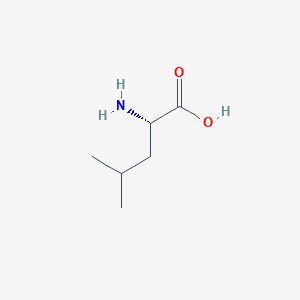| Synonyms |
Click to Show/Hide the Synonyms of This DIG
L-leucine; leucine; 61-90-5; (S)-2-Amino-4-methylpentanoic acid; (S)-Leucine; H-Leu-OH; (2S)-2-amino-4-methylpentanoic acid; (S)-(+)-Leucine; Leucin; L-Norvaline, 4-methyl-; (S)-2-Amino-4-methylvaleric acid; L-alpha-Aminoisocaproic acid; Leucin [German]; Leucine (VAN); LEUCINE, L-; leu; Leucinum; (2S)-alpha-leucine; L-(+)-Leucine; L-(-)-2-Amino-4-methylpentanoic acid; L-leucin; Leucine [USAN:INN]; Leucinum [INN-Latin]; Leucina [INN-Spanish]; FEMA No. 3297; Leucina [Latin,Spanish]; alpha-Aminoisocaproic acid; Valeric acid, 2-amino-4-methyl-, (S)-; 2-amino-4-methylvaleric acid; Pentanoic acid, 2-amino-4-methyl-, (S)-; 2-Amino-4-methylpentanoic acid, (S)-; UNII-GMW67QNF9C; L-Leuzin; AI3-08899; 2-Amino-4-methylvaleric acid (L); 2-Amino-4-methylpentanoic acid (L); MFCD00002617; NSC 46709; (2S)-alpha-2-amino-4-methylvaleric acid; POLY-L-LEUCINE; GMW67QNF9C; CHEMBL291962; L-Leucine, labeled with tritium; CHEBI:15603; NSC-46709; Leucine (L-Leucine); L-Leu; polyleucine; Leucina; Poly(L-leucine); (2S)-2-amino-4-methylpentanoate; L-a-Aminoisocaproic acid; EINECS 200-522-0; HSDB 7799; LeuOH; 1lan; 1usk; 3h-l-leucine; 4-methyl-norvalin; L-2-Amino-4-methylpentanoic acid; L-Leucine;; (L)-leucine; .alpha.-Amino-.gamma.-methylvaleric acid; (3H)Leucine; alpha-Amino-gamma-methylvaleric acid; H-Leu; Leucine (USP); L-a-Aminoisocaproate; 4-methyl-l-norvalin; L-Leucine,(S); 21675-61-6; Leucine (H-3); 4-methyl-L-Norvaline; L-Leu-OH; (2S)-2-amino-4-methyl-pentanoic acid; H-Leu-OH USP grade; L-Leucine, 99%; L-Leucine, homopolymer; PubChem13183; 1f2o; L-Leucine (JP17); L-alpha-Aminoisocaproate; bmse000042; bmse000920; EC 200-522-0; L-Leucine, 99%, FG; SCHEMBL3889; NCIStruc1_001860; NCIStruc2_000010; H-Leu-2-Chlorotrityl Resin; iso-C4H9CH(NH2)COOH; 2-amino-4-methyl-valericaci; 2-amino-4-methylpentanoicacid; 2-Amino-4-methyl-valeric acid; GTPL3312; L-.alpha.-Aminoisocaproic acid; (S)-2-Amino-4-methylvalerate; DTXSID9023203; Norvaline, 4-methyl-, (L)-; L-Leucine, Cell Culture Reagent; (S)-2-Amino-4-methylpentanoate; (s)-2-amino-4-methylvalericacid; Pharmakon1600-01301005; 25322-63-8; HY-N0486; NCI46709; STR01720; ZINC3645145; L-Leucine, Vetec(TM), 98.5%; ANW-33984; BDBM50219348; CCG-37658; NCGC00013565; NSC760100; s3753; Oxirane, 2,3-bis(2-chlorophenyl)-; (S)-2-Amino-4-methyl-pentanoic acid; 2-Amino-4-methylvaleric acid, (L)-; AKOS010373766; AKOS015841779; AM81871; CS-W020705; DB00149; MCULE-4930237913; NSC-760100; 2-Amino-4-methylpentanoic acid, (L)-; L-Leucine, tested according to Ph.Eur.; NCGC00013565-02; NCGC00096678-01; 25248-98-0; 71000-80-1; E641; 1-Leucine;2-Amino-4-methylpentanoic acid; L-Leucine, BioUltra, >=99.5% (NT); AB0011442; DB-029966; L-Leucine, SAJ special grade, >=99.0%; BB 0256932; L-Leucine, reagent grade, >=98% (HPLC); L0029; L-Leucine, Vetec(TM) reagent grade, >=98%; C00123; D00030; M-6077; M03060; 3,3,5-triiodo-L-thyronine-beta-D-glucuronoside; 34147-EP2289892A1; 34147-EP2301939A1; 34147-EP2305825A1; 34147-EP2311850A1; 002L617; Q483745; Q-201312; L-Leucine, certified reference material, TraceCERT(R); 2B9FF792-3CA1-4BEA-BC63-6D4E1A86714E; F8889-8638; Leucine, European Pharmacopoeia (EP) Reference Standard; Z1250208667; UNII-0O72R8RF8A component ROHFNLRQFUQHCH-YFKPBYRVSA-N; UNII-1QSS9D5DR6 component ROHFNLRQFUQHCH-YFKPBYRVSA-N; UNII-66PZQ62YA6 component ROHFNLRQFUQHCH-YFKPBYRVSA-N; UNII-N7U7BXP2OI component ROHFNLRQFUQHCH-YFKPBYRVSA-N; L-Leucine, United States Pharmacopeia (USP) Reference Standard; (S)-2-Amino-4-methyl-pentanoic acid methyl ester hydrochloride; L-Leucine, Pharmaceutical Secondary Standard; Certified Reference Material; L-Leucine, from non-animal source, meets EP, JP, USP testing specifications, suitable for cell culture, 98.5-101.0%; L-Leucine, PharmaGrade, Ajinomoto, EP, JP, USP, Manufactured under appropriate GMP controls for pharma or biopharmaceutical production, suitable for cell culture
|
 click to show the detail info of this DBT
click to show the detail info of this DBT

